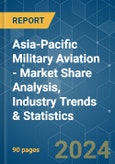Key Highlights
- Largest Market by Sub-Aircraft Type - Fixed-Wing Aircraft : The company's focus on enhancing combat capabilities by procuring technologically advanced combat aircraft across most of the countries in the region helps in the market growth.
- Fastest-growing Market by Sub-Aircraft Type - Fixed-Wing Aircraft : Rising geopolitical tensions and border conflicts between the countries in the region are driving the procurement of advanced multi-role aircraft to enhance their combat superiority.
- Largest Market by Body Type - Multi-Role Aircraft : The ability to perform ground strikes, air superiority, suppression of enemy air defenses, and electronic warfare missions drive the procurement of advanced multi-role aircraft.
- Largest Market by Country - India : Several border issues with neighboring countries and the increased threat of terrorism have prompted the country to spend a huge amount on its military equipment.
APAC Military Aviation Market Trends
Fixed-Wing Aircraft is the largest Sub Aircraft Type
- Asia-Pacific leads the military spending, as global military expenditure surpassed USD 2 trillion for the first time in 2021. Due to the expansion of the defense industries in East Asian countries, including Japan, South Korea, Taiwan, and Singapore, as well as China and India, defense budgets may continue to rise. Spending on the military in the region increased by more than 3.5%, surpassing that of Europe, Africa, and the Americas.
- For instance, India and China increased their military expenditures, with India spending over USD 77 billion and China spending USD 293 in 2021. Defense spending also increased in South Korea by 43%, in India by 33%, in China by 72%, in Indonesia by 35%, in Singapore by 24%, and in Thailand by 16%.
- In terms of operational fleet, the region has the largest fleet of aircraft and rotorcraft, with 14,529 aircraft. Out of these, combat aircraft constitute about 4,998, along with 520 special purpose aircraft, 46 tankers, 1,008 transport, and 3,079 training and helicopters. The fixed-wing aircraft segment is anticipated to occupy a major market share in the overall Asia-Pacific military aviation market during the forecast period. The region's market for fighter aircraft is expected to be driven by rising military spending.
- The demand for fighter aircraft in the region is also being fueled by the military modernization program of most Asian nations to replace their outdated fighter aircraft with newer generation aircraft to enhance their aerial combat capabilities.
India is the largest Country
- In 2021, Asia and Oceania spent a total of USD 586 billion on military expenditure. Over the past few years, terrorist operations have increased in nations like Afghanistan, Pakistan, India, and the Philippines. As a result, more anti-terrorism funding is being made available to combat terrorism at the domestic and international levels. In the coming years, the region's economy is expected to be hampered by the ongoing trade war between China and the United States.
- Territorial disputes in the South China Sea and China's dominance over the Sea are also prompting various countries such as the Philippines, Indonesia, and Malaysia to spend more on their military equipment.
- During the forecast period, China, India, and South Korea are expected to procure the highest number of aircraft. China will likely procure around 700 aircraft, including 500 Mi-17 helicopters and 200 J-20 fixed-wing aircraft. South Korea will likely procure 357 aircraft, including 70 fixed-wing aircraft and 287 helicopters. India will likely procure around 707 aircraft, including 605 fixed-wing aircraft and 102 rotorcraft.
- Some of the other major procurements in the region are Japan's procurement of 283 aircraft, including 133 fixed-wing aircraft and 150 Bell 412 helicopters. Australia is also expected to procure 118 aircraft, including 85 fixed-wing aircraft and 33 rotorcraft.
- During the forecast period, Thailand, Singapore, Malaysia, the Philippines, and Indonesia are projected to cumulatively procure around 137 aircraft. Taiwan is also expected to acquire around 60 aircraft, and Pakistan plans to acquire 44 aircraft during the forecast period.
APAC Military Aviation Industry Overview
The Asia-Pacific Military Aviation Market is fairly consolidated, with the top five companies occupying 84.21%. The major players in this market are Airbus SE, Aviation Industry Corporation of China, Ltd, Dassault Aviation, Lockheed Martin Corporation and The Boeing Company (sorted alphabetically).Additional Benefits:
- The market estimate (ME) sheet in Excel format
- 3 months of analyst support
Table of Contents
Companies Mentioned (Partial List)
A selection of companies mentioned in this report includes, but is not limited to:
- Airbus SE
- Aviation Industry Corporation of China, Ltd
- Dassault Aviation
- Embraer
- Hindustan Aeronautics Limited
- Korea Aerospace Industries
- Leonardo S.p.A
- Lockheed Martin Corporation
- Textron Inc.
- The Boeing Company
Methodology

LOADING...










